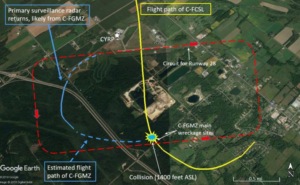May 2, 2019
TSB Releases Non-Conclusive Report on Carp Midair
admincopa
In a report made public today (May 2), the Transportation Safety Board highlights the “inherent limitations of the see-and-avoid principal” among other factors that led to the November 4, 2018 mid-air collision between a Piper Cheyenne and a Cessna 150 over Ottawa/Carp airport (CYRP) and resulted in the death of the Cessna pilot.
According to the investigative report, the Piper PA-42 Cheyenne III (C-FCSL) was on a visual approach to Carp airport and crossed over midfield from the upwind side before beginning a turn to join the downwind leg for a landing on Runway 28. It was as the Cheyenne began its turn to join the downwind that it collided with the Cessna, shearing off part of the Cessna’s left wing and aileron and causing it to plummet to the ground in a near-vertical trajectory. The Cheyenne received damage to its right main landing gear but its primary flight controls were unaffected and its pilot elected to land at nearby Ottawa international airport (CYOW).
The TSB investigators report that the Cheyenne pilot made at least three calls on the Airport Traffic Frequency (ATF) announcing his intentions, the first one 5 nm out, the second while overflying Carp and the last before turning to join the downwind leg of the circuit. The TSB points out that calls on an ATF are recommended only, and not mandatory.
Based on weak primary radar returns, the TSB concluded the Cessna 150G (C-FGMZ) was conducting circuits for Runway 28. According to the Cheyenne pilot and other pilots in the area at the time, no radio transmissions were heard from the Cessna pilot.

The TSB noted that, after a subsequent examination of the Cessna’s transceiver by their engineering laboratory, no conclusion of its serviceability could be made due to post-impact damage. An examination of the Cheyenne’s radio uncovered no indication of a malfunction.
Other comments included by the TSB in its report cited an earlier recommendation that light aircraft that are not currently required to be equipped with flight data or cockpit voice recorders, be required to be equipped with ‘lightweight flight recording systems’.
Noting that the Cessna was equipped with a 121.5 MHz emergency locator transmitter (ELT), which is no longer monitored by search and rescue satellites, and not with the currently monitored 406 MHz technology, the TSB cited an earlier recommendation that all Canadian-registered and foreign aircraft operating in Canada be equipped with a 406 MHz ELT.
Photo courtesy of the TSB
The full report can be viewed below:
a18o0150-e